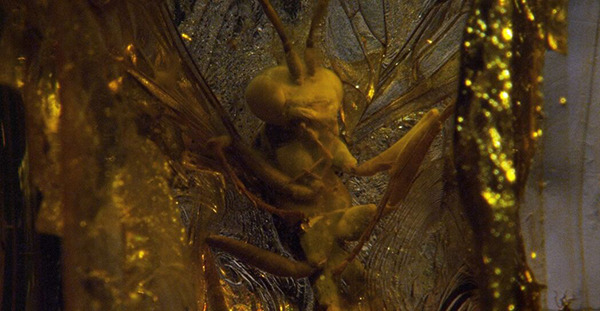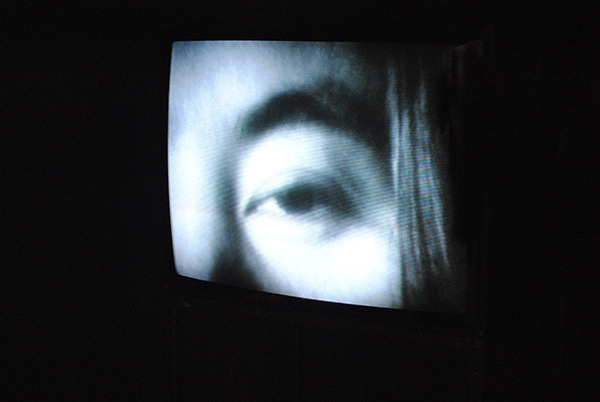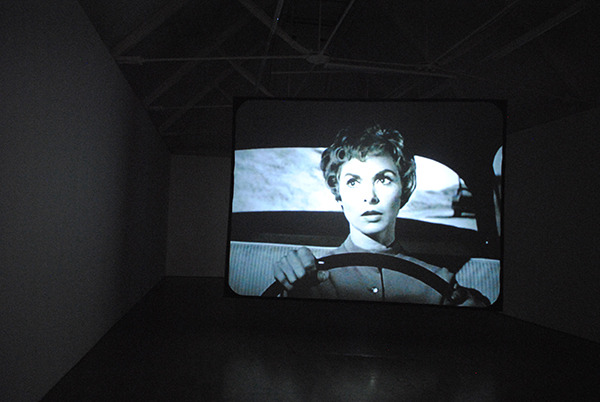Artlyst has attended the latest exhibition at Modern Art Oxford, The Indivisible Present, the first exhibition in KALEIDOSCOPE, a yearlong programme of unfolding exhibitions at the gallery in 2016 to celebrate Modern Art Oxford’s 50th anniversary. All the works on display will explore temporality in art as a celebration of the longevity of the gallery, with visitors to the exhibition being able to see the processes of exhibition-making first hand as another temporal aspect of the exhibition, as the art changes throughout the year.
Current works on display include pieces by Douglas Gordon, Pierre Huyghe, John Latham, Yoko Ono, Elizabeth Price, Dog Kennel Hill Project and Viola Yeşiltaç, encompassing film, photography, sculpture and installation, with all having a common factor; that of time.
 Image: Pierre Huyghe, De-extinction (2014), detail. The Indivisible Present, Modern Art Oxford. Photo: courtesy of the gallery.
Image: Pierre Huyghe, De-extinction (2014), detail. The Indivisible Present, Modern Art Oxford. Photo: courtesy of the gallery.
Upon entering the show the viewer is met by Pierre Huyghe’s engrossing video installation De-extinction (2014) which is being shown for the first time in a UK public gallery. The work records a moment of reproduction frozen in time, with two mosquitos encased in amber, an act suspended over 30 million years ago. The artist’s video work reflects the vastness of geological time as opposed to our own fleeting existence. The work plays with notions of microcosm and macrocosm, as the camera picks up every minutia of detail. Bubbles transform into planets and star-fields with Kubrickian results.
Yoko Ono’s Eye-Blink (1966) is a work that was exhibited in the artist’s 1997 solo exhibition at Modern Art Oxford. The video piece on an old monitor features a close-up of Ono’s eye opening and closing very slowly, the work draws our attention at the same time as referencing our gaze, and the subjective experience of time passing, juxtaposed with the objectification of subject – all the while being a wry wink to the viewer.
 Image: Yoko Ono, Eye-Blink (1966), The Indivisible Present Modern Art Oxford. Photo: P A Black © Artlyst 2016.
Image: Yoko Ono, Eye-Blink (1966), The Indivisible Present Modern Art Oxford. Photo: P A Black © Artlyst 2016.
Turner Prize winner Elizabeth Price’s film installation Sleep (2013) is a mesmerising assault on the senses referring to the standby mode of digital devices as opposed to our own state of rest, which the work questions in our all encompassing digital age. Incorporating the image of a never-setting sun captured through increasingly evolving technology, until the sun was filmed relentlessly 24 hours of the day. The sun never sets, the lights never go out, we are always awake.
I Really Must Congratulate You on Your Attention to Detail (2016), is a series of new photographs from Viola Yeşiltaç’s ongoing series. The artist creates fragile paper sculptures, which are then temporarily balanced and then photographed at the point of collapse, capturing the millisecond of the work’s stability and enabling the viewer a sustained view of the ephemeral, resulting in colourful abstract images blurring the boundaries between painting and photography.
We have another step back in time with the presentation of two sculptures by John Latham, which were exhibited in his Art after Physics retrospective at Modern Art Oxford in 1991. The artist consistently employed books in his paintings, sculptures and performances over a fifty-year period. Juxtaposing destruction with the art of creation by incorporating burned and charred books in his work, Latham blurred the boundaries of object and action, a document of an event, a temporal stamp on the performative act of destruction, the works reflect the transformative nature of time.
 Image: Douglas Gordon, 24 Hour Psycho (1993). The Indivisible Present, Modern Art Oxford. Photo: P A Black © Artlyst 2016.
Image: Douglas Gordon, 24 Hour Psycho (1993). The Indivisible Present, Modern Art Oxford. Photo: P A Black © Artlyst 2016.
Lastly we find ourselves studying Turner Prize-winning artist Douglas Gordon’s celebrated film installation 24 Hour Psycho (1993) where the artist famously slowed down the classic Hitchcock film Psycho to play over a 24-hour period. The piece was a seminal work for Gordon, and was included in Modern Art Oxford’s 1999’s Notorious: Hitchcock and Contemporary Art. The piece induces a meditative state in the viewer, transformative of both time and film; each frame becomes an individual work of art, as the image methodically slips to the next frame, becoming an intimate study of subject matter and the nature of film and the image – one can literally watch it for hours.
The indivisible Present is a strong show for Modern Art Oxford’s 50th Anniversary celebrations, a minimal well curated, thematically and conceptually successful exhibition incorporating past, present, and future – as the show evolves throughout the year – and Artlyst will bring you that evolution as it unfolds.
About Modern Art Oxford:
The gallery was founded in 1966, Modern Art Oxford has an international reputation for ambitious and innovative projects, with all events completely free of charge, unless stated. The gallery aims to make contemporary art accessible and engaging to the widest audience through presentation and participation. The programme celebrates the relevance of contemporary visual culture to society today. Modern Art Oxford has an agenda shaped by a belief in dialogue between contemporary art and ideas, and seeks to create new relationships between artists and audiences at the beginning of the 21st century.
Lead image: Pierre Huyghe, De-extinction (2014), detail. The Indivisible Present, Modern Art Oxford. Photo courtesy of the gallery.
Words: Paul Black. Photos: P A Black © Artlyst 2016.
KALEIDOSCOPE: The Indivisible Present – Modern Art Oxford – until 16 April 2016.

